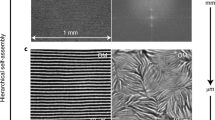Abstract.
The formation of highly oriented cluster arrays by chemical deposition of platinum onto a regular 2D protein template is studied. The crystalline bacterial surface layer (S layer) of Sporosarcina ureae exhibiting a p4 symmetry with a lattice spacing of 13.2 nm is used as the protein template. Cluster deposition onto the S layer is achieved by chemical reduction of a platinum salt. The growth kinetics of the clusters has been examined by UV–VIS spectrometry. Transmission electron microscopy reveals the formation of well separated metal clusters with an average diameter of 1.9±0.6 nm. The lateral cluster arrangement is defined by the underlying protein crystal. We observe 7 cluster sites per unit cell corresponding to a density of 4×1012 cm-2. They are located in the nano-sized pores and gaps of the crystalline S layer.
Similar content being viewed by others
Author information
Authors and Affiliations
Additional information
Received: 2 September 1998 / Received in final form: 14 January 1999
Rights and permissions
About this article
Cite this article
Mertig, M., Kirsch, R., Pompe, W. et al. Fabrication of highly oriented nanocluster arrays by biomolecular templating. Eur. Phys. J. D 9, 45–48 (1999). https://doi.org/10.1007/s100530050397
Issue Date:
DOI: https://doi.org/10.1007/s100530050397




